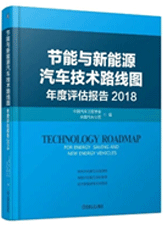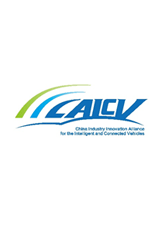

|
The journal Automotive Innovation is sponsored by China SAE, published through Springer, distributed around the world, and reflects the top-level research and technical advance of automotive engineering. Automotive Innovation newsletter in December includes the following contents: 1. A Glimpse of Experts-Prof. Fang Chen from Chalmers University of Technology, Sweden 2. Article Recommendation-Four papers on technology of ICV, EV and HEV 3. China SAE News: · Automotive Innovation Special Issue on HMI is calling for papers, and the deadline is on April 15, 2019 · Annual Assessment Report 2018 of Technology Roadmap for Energy-saving and New Energy Vehicles was published · V2X White Paper - A Connected Vehicle and Intelligent Transportation Platform for Zero Congestion in Cities - issued by three alliances · TMC2019 will be held in Shanghai on April 19-20, 2019 |

 Prof. Fang Chen Professor in Interaction Design Group, Department of Computing Science and Engineering, Chalmers University of Technology, Sweden |
Research interests Auditory ergonomics, human factors and speech technology, human factors in multi-model interface design and working in the cold. From 2004, her most interesting and focus are the human-system interaction and culture aspects in future vehicle design for traffic safety. |
||
|
Achievements In 1993, Saab JAS39 battleplane was crashed in a performance of Water Festival, Stockholm. The reason of this accident was investigated that the aircraft interaction system led the pilot’s misjudgment and thus curried out the incorrect operation. Subsequently, she took the project leader for two research projects concerning human-computer-interaction: human factors in 3D audio presentation and human factors in speech technology application. The research directly upgraded the auditory interaction system in the next generation of JAS39. Research results also have led to new projects to integrate multi-modal applications in complex control systems. From 2006, she has been trying to introduced vehicle interaction design to China. Since 2013, she has been working together with Chinese partners including Tsinghua University to organize conference on HMI every year in order to promote the development of vehicle HMI design, especially in Chinese vehicle market. |
|||
|
Perspective: challenges and development trends for HMI With improving of automatic driving and V2X technology, how to transmit the information to the drivers or even other road users has been becoming a challenging issue, especially concerning about the safety and user experience. |

   
|
Analysis of Typical Automakers’ Strategies for Meeting the Dual-Credit Regulations Regarding CAFC and NEVs Yue Wang, Fuquan Zhao, Yinshuo Yuan, Han Hao, Zongwei Liu |
||
| The parallel corporate average fuel consumption (CAFC) and new energy vehicle (NEV) credit schemes that have been introduced by the Ministry of Industry and Information Technology of China is an innovative attempt to simultaneously regulate conventional gasoline vehicles (CGVs) and NEVs in the passenger vehicle sector that is expected to function as a long-term management mechanism for CGVs to be more energy-efficient and NEVs to be well-promoted. This will have a significant impact on trends in China’s automotive industry and automakers’ business decisions. Taking the cases of four typical automakers with different levels of average fuel economy in their CGVs and advanced NEV production, scenario analysis has been applied to generate these automakers’ alternatives in relation to compliance with the dual-credit regulations in force from 2017 to 2020 based on the Interim Measures on the Joint Management of CAFC and NEV Credits (Draft). These automakers’ alternative approaches to compliance are compared. Further, in view of the financial losses as a result of halted production if they fail to comply, the values of CAFC and NEV credits and corresponding influencing factors are analyzed from the automakers’ perspective. Finally, the most cost-effective compliance strategies for these automakers are summarized and suggested improvements in the regulations are proposed for the government. | |||
|
Keywords: Automotive industry · Dual-credit management · Credit trading market · Fuel consumption · New energy vehicle Wang, Y., Zhao, F., Yuan, Y., et al.: Analysis of Typical Automakers’ Strategies for Meeting the Dual-Credit Regulations Regarding CAFC and NEVs. Automotive Innovation 1(1), 15-23(2018) |
|||
| Full Paper Reading>> | |||
   
|
Blind Spot Obstacle Detection from Monocular Camera Images with Depth Cues Extracted by CNN Yuxiang Guo, Itsuo Kumazawa, Chuyo Kaku |
||
| The images from a monocular camera can be processed to detect depth information regarding to obstacles in the blind spot area captured by the side-view camera of a vehicle. The depth information is given as a classification result “near” or “far” when two blocks in the image are compared with respect to their distances and the depth information can be used for the purpose of blind spot area detection. In this paper, the proposed depth information is inferred from a combination of blur cues and texture cues. The depth information is estimated by comparing the features of two image blocks selected within a single image. A preliminary experiment demonstrates that a convolutional neural network (CNN) model trained by deep learning with a set of relatively ideal images achieves good accuracy. The same CNN model is applied to distinguish near and far obstacles according to a specified threshold in the vehicle blind spot area, and the promising results are obtained. The proposed method uses a standard blind spot camera and can improve safety without other additional sensing devices. Thus, the proposed approach has the potential to be applied in vehicular applications for the detection of objects in the driver’s blind spot. | |||
|
Keywords: Coarse-to-Fine Analysis · Convolutional Neural Network · Blind Spot Detection · Principal Component Analysis · Discrete Cosine Transformation Guo, Y., Kumazawa, I., Kaku, C.: Blind Spot Obstacle Detection from Monocular Camera Images with Depth Cues Extracted by CNN. Automotive Innovation 1(3), 362-373 (2018) |
|||
| Full Paper Reading>> | |||
   
|
Highly Fuel-Efficient Transmission and Propulsion Concepts Ferit Küçükay, Andreas Lange, Lin Li |
||
| The integration of one or more electric machines into the drivetrain has resulted in many different powertrain concepts in recent years, ranging from the P2 hybrid to dedicated hybrid transmission (DHT). Two types of DHT with different characteristics are investigated. The first type is the power split hybrid (PS-DHT), which has very low mechanical complexity but needs high electrical effort in the transmission. The second type is multi-mode DHT (MM-DHT), which has a slightly higher mechanical complexity but much less electrical effort when compared with the PS-DHT. A transmission synthesis is used to determine the concept of the MM-DHT. The three different powertrain concepts (i.e., P2, PS-DHT, and MM-DHT) are analyzed and evaluated regarding fuel economy and performance. Legal driving cycles (e.g., Worldwide Harmonized Light Vehicles Test Procedure) and the 3D method (driver, driven vehicle, driving environs) are used to investigate the drivetrain in the context of real driving operation. Results show that the two DHT concepts offer better fuel economy than the P2 hybrid drivetrain while still providing the same or even better driving performance. The study also shows that new hybrid concepts created with transmission synthesis can lead to further improvements in hybrid powertrains. | |||
|
Keywords: Dedicated hybrid transmission · Three-dimensional method · Drive train design · Fuel economy ·Driving performance Küçükay, F., Lange, A., Li, L.: Highly Fuel-Efficient Transmission and Propulsion Concepts, Automotive Innovation 1(1), 35-42(2018) |
|||
| Full Paper Reading>> | |||
   
|
Cost-efficient Thermal Management for a 48V Li-ion Battery in a Mild Hybrid Electric Vehicle Chao Yu, Guangji Ji, Chao Zhang, John Abbott, Mingshen Xu, Pieter Ramaekers, Jianxiang Lu |
||
| The 48V mild hybrid system is a cost-efficient solution for original equipment manufacturers to meet increasingly stringent fuel consumption requirements. However, hybrid functions such as auto stop/start and brake regeneration are unavailable when a 48V battery is at very low temperature because of its limited charge and discharge capability. Therefore, it is important to develop cost-efficient thermal management to warm up the battery of a 48V mild hybrid electric vehicle (HEV) to recover hybrid functions quickly in cold climate. Following the model-based “V” process, we first define the requirements and then design different mechanisms to heat a 48V battery. Afterwards, we build a 48V battery model in LMS AMESim and conduct co-simulation with simplified battery management system and hybrid control unit algorithms in Matlab Simulink for analysis. Finally, we carry out a series of vehicle experiments at low temperature and observe the effect of heating to validate the design. Both simulation results and experimental data show that a cold 48V battery placed in a cabin with hot air can be heated effectively in the developed “Enhanced Generator Mode with 48V Battery” mode. The entire design is in a newly developed software that cyclically charges and discharges a 48V battery for quick warm-up in cold temperature without needing any additional hardware such as a heater, making it a cost-efficient solution for HEVs. | |||
|
Keywords: 48V Li-ion Battery· Thermal Management· Mild Hybrid Electric Vehicle· Battery Modeling Yu, C., Ji, G., Zhang, C., et al.: Cost-efficient Thermal Management for a 48V Li-ion Battery in a Mild Hybrid Electric Vehicle. Automotive Innovation 1(3), 320-330(2018) |
|||
| Full Paper Reading>> | |||

 |
|||
| Automotive Innovation Special Issue on HMI is calling for papers | |||
|
HMI technology not only affects the experience of vehicle drivers, but also is a key point to enhance vehicle performance and brand competitiveness, and is an important guarantee for safety in the era of automated driving as well. With the rapid development of artificial intelligence (AI), augmented reality (AR) and
the functional requirement in ADAS and automated driving, HMI design has become an important symbol of ICV innovation.
So Automotive Innovation Special issue on HMI is planned, and Prof. Fang Chen is invited as the guest editor-in-chief. The special issue is calling for papers on HMI around the world, and the deadline is April 15, 2019. Online submission:http://www.springer.com/42154 |
|||
 |
|||
| Annual Assessment Report 2018 of Technology Roadmap for Energy-saving and New Energy Vehicles was published | |||
| This report is jointly compiled by China SAE and Toyota Motor Corporation and written according to the “1+7" technical fields mentioned in the Technology Roadmap for Energy-saving and New Energy Vehicles, and includes comprehensive assessment and thematic evaluation of new energy vehicles. The report shows that China's energy-saving automobile technology continued to develop in 2017 and 2018, and was accelerated integrating with electrification and intellectualization, resulting in a decrease in the average fuel consumption of new passenger cars. The performance of EV and PHEV was improved comprehensively, and products were continuously upgraded iteratively, and the trend of integration of electrification and intellectualization became more and more obvious, and many technical progresses are made, including in energy density of power batteries and manufacturing technology. Fuel cell vehicles have made remarkable progress in power systems and key components, and more than 1000 FCVs have been demonstrated in many cities. ICV has made positive progress in capacity building of standards and regulations, key technologies on vehicles and cyber and industrial chain layout as well, and key technologies in some areas have kept pace with the world. The application of automobile lightweight has been improved rapidly. and great progress has been made in the industrial application of high performance aluminium alloy and carbon fiber. | |||
 |
|||
| V2X White Paper - A Connected Vehicle and Intelligent Transportation Platform for Zero Congestion in Cities - Issued by Three Alliances | |||
|
While Cooperative Vehicle Infrastructure System (CVIS) has the particularity of cross-industry and cross-sector, alliances in the fields of automobile, transportation and communication, including China Industry Innovation Alliance for the Intelligent and Connected Vehicle (CAICV), China ITS Industry Alliance (C-ITS), C - V2X working group of promotion team of IMT-2020(5G), jointly compiled this white paper. With the aim of promoting the application of CVIS and alleviating traffic congestion effectively and improving the traffic efficiency, the research creates a new platform architecture of CVIS, and suggests the roles and coordination tasks of the government and all parties in the industrial chain.
This white paper argues that the development of CVIS will be based on V2X technology and combined with several emerging technologies, such as artificial intelligence, cloud computing and big data. The more effective combination between data, external resources and application service, offering innovative functional service domain and more flexible industry application, is the new platform of CVIS. Based on the in-depth analysis of the causes of traffic congestion, the white paper proposes six functional service domains and creates the architecture of the new platform of CVIS according to the functional service domain.
Download:http://www.chinasaejournal.com.cn/a2711.html |
|||
 |
|||
| TMC2019 will be held on April 19-20, 2019 in Shanghai | |||
|
The 11th International Symposium on Automotive Transmission and Drive Technology (TMC2019) will take place in Shanghai on April 19-20, 2019 (starting from the second professional day of Shanghai auto show). While continuing to introduce transmission upgrading technology, this event will mainly present and discuss electrified drive systems, including hybrid and pure electrical drives, and will pay more attention to the discussion of development, testing and EV drive technologies.
TMC is China's most influential transmission and drive technology conference, aimed at leading technology direction, improve R & D capability and promote industrial chain integration. TMC2019 is expected to assemble about 50 speeches, 60 exhibitors and 900 professional participants.
Website:http://www.transmission-china.org/ |
|||

|
Automotive Innovation The first top English academic journal of China’s Automotive Industry ● Global subscription ● Reflecting the top-level research and technical advance of automotive engineering ● A good platform for demonstrating the technology innovation on automobiles Editors-in-Chief Li Jun, Academician of CAE, President of China SAE, Professor of Tsinghua University Frank Zhao, President (2018-2020) of FISITA, President of Tsinghua Automotive Strategy Research Institute Executive Editor-in-Chief Prof. Mike Ma,Executive Chief Editor of Automotive Innovation, Professor of Jilin University, VP Technical FISITA |
||||
|
Paper submission and browse www.ChinaSAEJournal.com.cn www.springer.com/42154 Contacts: Ms. Huisi, Gu Tel: +86-10-50950101 Email: ghs@sae-china.org |

|
|||
|
Sponsored |
Co-operated with
|
|||